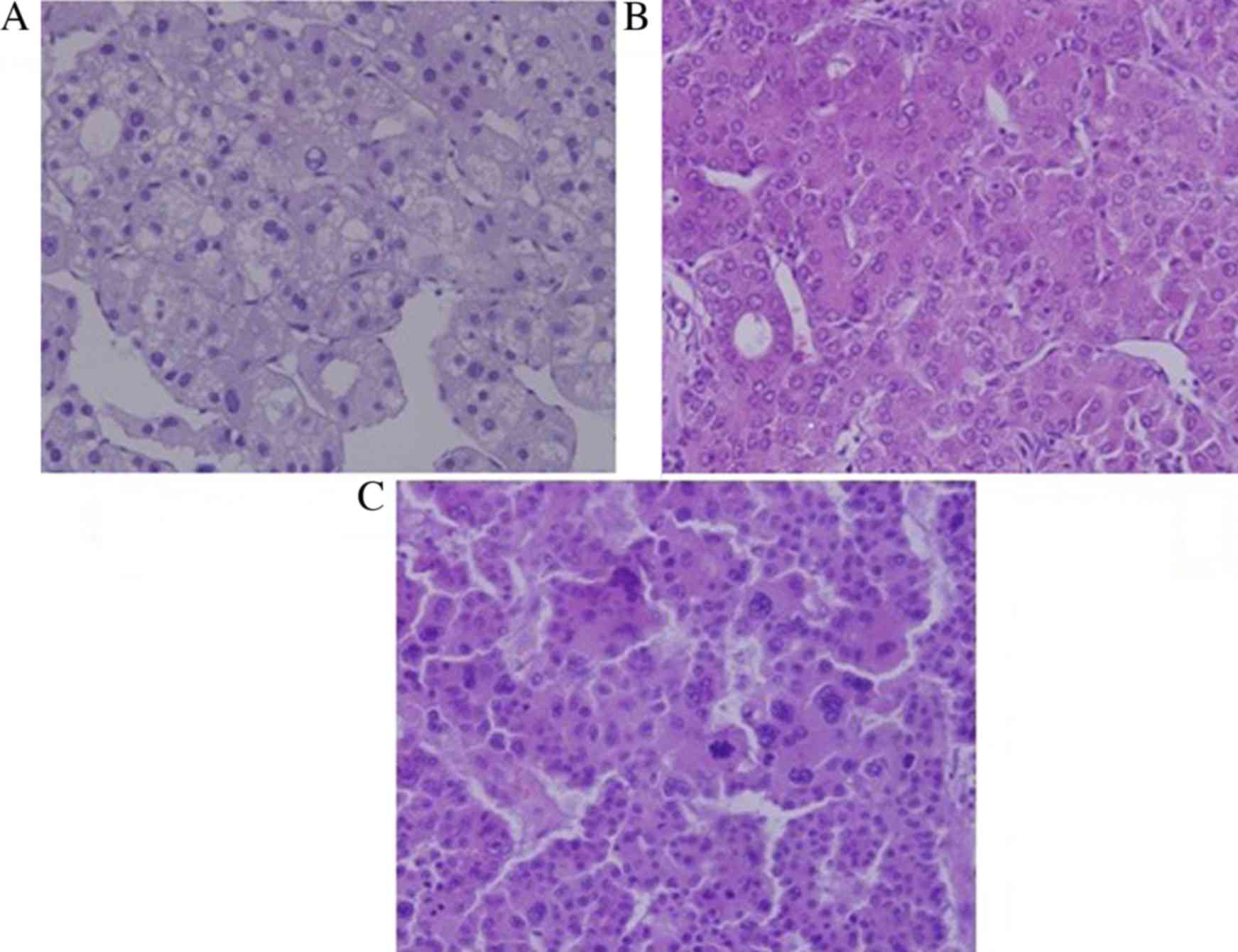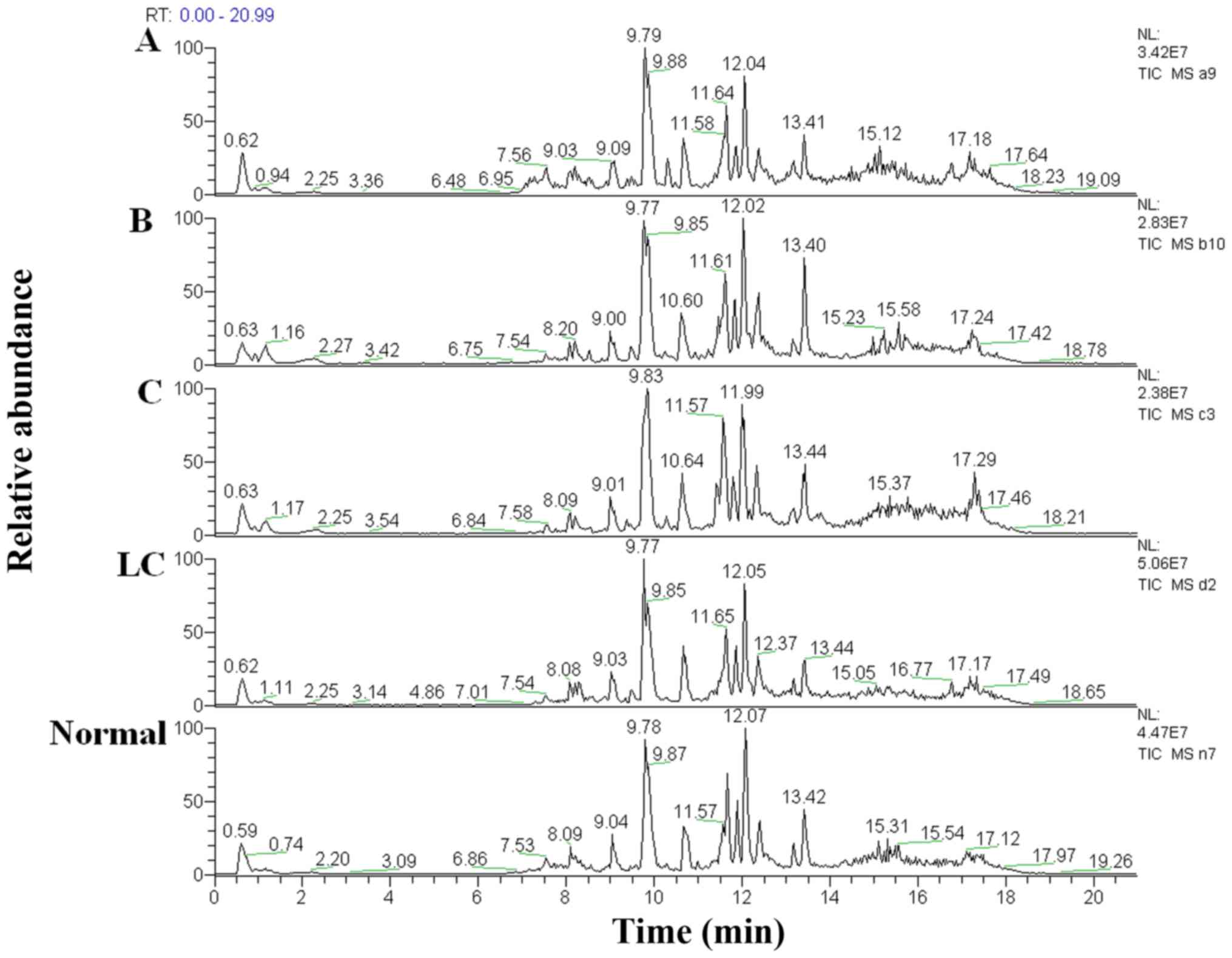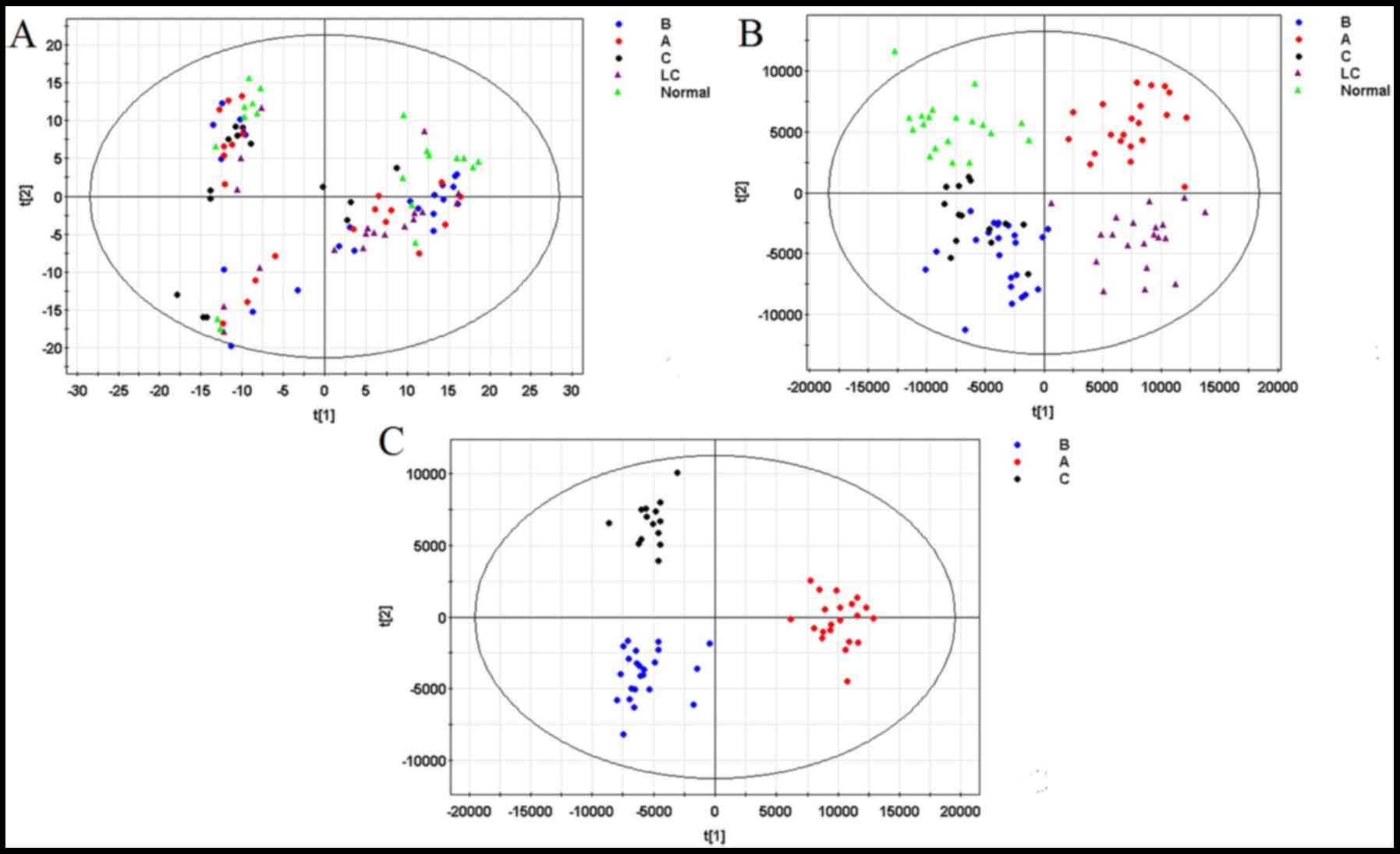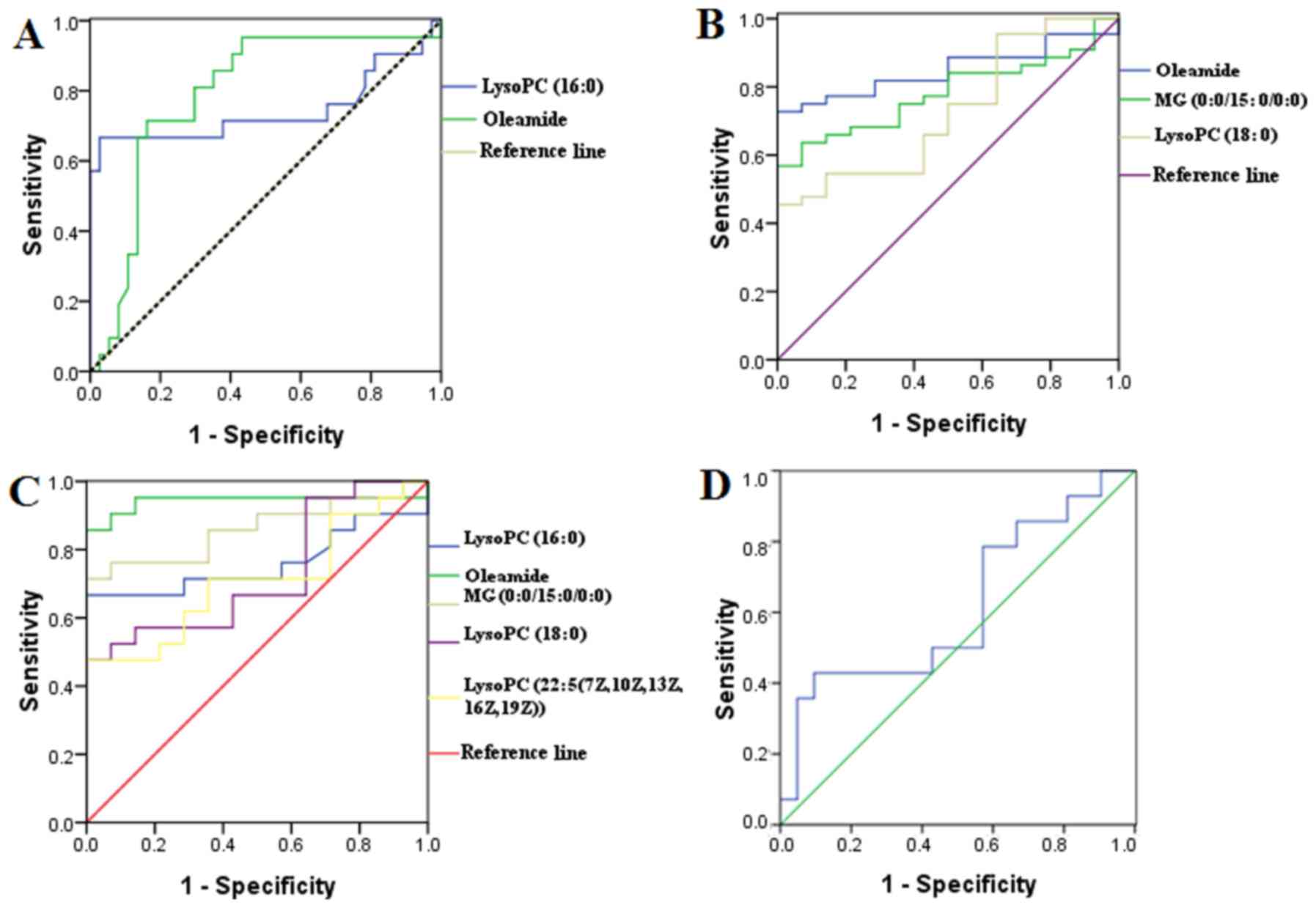|
1
|
El-Serag HB: Hepatocellular carcinoma. N
Engl J Med. 365:1118–1127. 2011. View Article : Google Scholar : PubMed/NCBI
|
|
2
|
Patel M, Shariff MI, Ladep NG,
Thillainayagam AV, Thomas HC, Khan SA and Taylor-Robinson SD:
Hepatocellular carcinoma: Diagnostics and screening. J Eval Clin
Pract. 18:335–342. 2012. View Article : Google Scholar : PubMed/NCBI
|
|
3
|
Liu Y, Hong Z, Tan G, Dong X, Yang G, Zhao
L, Chen X, Zhu Z, Lou Z, Qian B, et al: NMR and LC/MS-based global
metabolomics to identify serum biomarkers differentiating
hepatocellular carcinoma from liver cirrhosis. Int J Cancer.
135:658–668. 2014. View Article : Google Scholar : PubMed/NCBI
|
|
4
|
Qiang L, Huikai L, Butt K, Wang PP and Hao
X: Factors associated with disease survival after surgical
resection in Chinese patients with hepatocellular carcinoma. World
J Surg. 30:439–445. 2006. View Article : Google Scholar : PubMed/NCBI
|
|
5
|
Shah SA, Greig PD, Gallinger S, Cattral
MS, Dixon E, Kim RD, Taylor BR, Grant DR and Vollmer CM: Factors
associated with early recurrence after resection for hepatocellular
carcinoma and outcomes. J Am Coll Surg. 202:275–283. 2006.
View Article : Google Scholar : PubMed/NCBI
|
|
6
|
Martins A, Cortez-Pinto H, Marques-Vidal
P, Mendes N, Silva S, Fatela N, Glória H, Marinho R, Távora I,
Ramalho F and de Moura MC: Treatment and prognostic factors in
patients with hepatocellular carcinoma. Liver Int. 26:680–687.
2006. View Article : Google Scholar : PubMed/NCBI
|
|
7
|
Edmondson HA and Steiner PE: Primary
carcinoma of the liver: A study of 100 cases among 48,900
necropsies. Cancer. 7:462–503. 1954. View Article : Google Scholar : PubMed/NCBI
|
|
8
|
Stigliano R, Marelli L, Yu D, Davies N,
Patch D and Burroughs AK: Seeding following percutaneous diagnostic
and therapeutic approaches for hepatocellular carcinoma. What is
the risk and the outcome? Seeding risk for percutaneous approach of
HCC. Cancer Treat Rev. 33:437–447. 2007. View Article : Google Scholar : PubMed/NCBI
|
|
9
|
Pawlik TM, Gleisner AL, Anders RA,
Assumpcao L, Maley W and Choti MA: Preoperative assessment of
hepatocellular carcinoma tumor grade using needle biopsy:
Implications for transplant eligibility. Ann Surg. 245:435–442.
2007. View Article : Google Scholar : PubMed/NCBI
|
|
10
|
Nicholson JK, Lindon JC and Holmes E:
‘Metabonomics’: Understanding the metabolic responses of living
systems to pathophysiological stimuli via multivariate statistical
analysis of biological NMR spectroscopic data. Xenobiotica.
29:1181–1189. 1999. View Article : Google Scholar : PubMed/NCBI
|
|
11
|
Fiehn O: Metabolomics-the link between
genotypes and phenotypes. Plant Mol Biol. 48:155–171. 2002.
View Article : Google Scholar : PubMed/NCBI
|
|
12
|
European Association of the Study of the
Liver, . 2011 European Association of the Study of the Liver
hepatitis C virus clinical practice guidelines. Liver Int.
32:(Suppl 1). 2–8. 2012. View Article : Google Scholar
|
|
13
|
de Bruijne J, Buster EH, Gelderblom HC,
Brouwer JT, de Knegt RJ, van Erpecum KJ, Schalm SW, Bakker CM,
Zaaijer HL, Janssen HL, et al: Treatment of chronic hepatitis C
virus infection-Dutch national guidelines. Neth J Med. 66:311–322.
2008.PubMed/NCBI
|
|
14
|
Pluskal T, Castillo S, Villar-Briones A
and Oresic M: MZmine 2: Modular framework for processing,
visualizing, and analyzing mass spectrometry-based molecular
profile data. BMC Bioinformatics. 11:3952010. View Article : Google Scholar : PubMed/NCBI
|
|
15
|
Trygg J, Holmes E and Lundstedt T:
Chemometrics in metabonomics. J Proteome Res. 6:469–479. 2007.
View Article : Google Scholar : PubMed/NCBI
|
|
16
|
Eriksson L, Johansson E, Lindgren F,
Sjostrom M and Wold S: Megavariate analysis of hierarchical QSAR
data. J Comput Aided Mol Des. 16:711–726. 2002. View Article : Google Scholar : PubMed/NCBI
|
|
17
|
Yin P, Wan D, Zhao C, Chen J, Zhao X, Wang
W, Lu X, Yang S, Gu J and Xu G: A metabonomic study of hepatitis
B-induced liver cirrhosis and hepatocellular carcinoma by using
RP-LC and HILIC coupled with mass spectrometry. Mol Biosyst.
5:868–876. 2009. View
Article : Google Scholar : PubMed/NCBI
|
|
18
|
Liu SY, Zhang RL, Kang H, Fan ZJ and Du Z:
Human liver tissue metabolic profiling research on hepatitis B
virus-related hepatocellular carcinoma. World J Gastroenterol.
19:3423–3432. 2013. View Article : Google Scholar : PubMed/NCBI
|
|
19
|
DuBay D, Sandroussi C, Sandhu L, Cleary S,
Guba M, Cattral MS, McGilvray I, Ghanekar A, Selzner M, Greig PD
and Grant DR: Liver transplantation for advanced hepatocellular
carcinoma using poor tumor differentiation on biopsy as an
exclusion criterion. Ann Surg. 253:166–172. 2011. View Article : Google Scholar : PubMed/NCBI
|
|
20
|
Yaprak O, Akyildiz M, Dayangac M, Demirbas
BT, Guler N, Dogusoy GB, Yuzer Y and Tokat Y: AFP level and
histologic differentiation predict the survival of patients with
liver transplantation for hepatocellular carcinoma. Hepatobiliary
Pancreat Dis Int. 11:256–261. 2012. View Article : Google Scholar : PubMed/NCBI
|
|
21
|
Jiang T, Wang J, Luo Z, Zhu K, Chen J and
Shan H: Study of apparent diffusion coefficient value and
histopathological differentiation of hepatocellular carcinoma.
Zhonghua Yi Xue Za Zhi. 95:187–191. 2015.(In Chinese). PubMed/NCBI
|
|
22
|
Feng Y, Qin XC, Luo Y, Li YZ and Zhou X:
Efficacy of contrast-enhanced ultrasound washout rate in predicting
hepatocellular carcinoma differentiation. Ultrasound Med Biol.
41:1553–1560. 2015. View Article : Google Scholar : PubMed/NCBI
|
|
23
|
Ryborg AK, Johansen C, Iversen L and
Kragballe K: Lysophosphatidylcholine induces keratinocyte
differentiation and upregulation of AP-1- and NF-kappaB DNA-binding
activity. Acta Derm Venereol. 84:433–438. 2004. View Article : Google Scholar : PubMed/NCBI
|
|
24
|
Zhou L, Ding L, Yin P, Lu X, Wang X, Niu
J, Gao P and Xu G: Serum metabolic profiling study of
hepatocellular carcinoma infected with hepatitis B or hepatitis C
virus by using liquid chromatography-mass spectrometry. J Proteome
Res. 11:5433–5442. 2012. View Article : Google Scholar : PubMed/NCBI
|
|
25
|
Mueller GP and Driscoll WJ: Biosynthesis
of oleamide. Vitam Horm. 81:55–78. 2009. View Article : Google Scholar : PubMed/NCBI
|


















